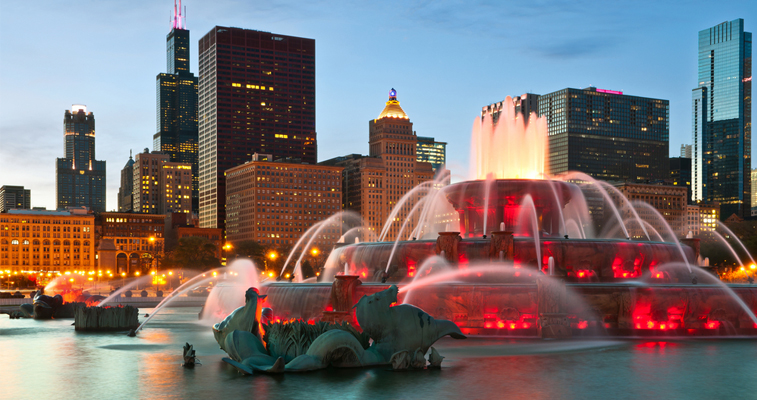The architectural heart of the United States
Monday, June 23, 2014

Chicago is a city of change, but if there is one thing that remains the same and makes Chicago like nowhere else, it is its architecture, which bears the seal of great names like Louis Sullivan, Mies van der Rohe, Daniel Burnham and Frank Lloyd Wright.
A fire in 1871 which lasted three days totally destroyed the center and made the Chicago of today possible. The opportunity to give the urban environment a new face attracted those then-young architects who, along with some others, formed the famous Chicago School. Their fascination with functionality, steel structures and high-speed elevators led them to create the city’s icon par excellence: the modern skyscraper.
You need do no more than take a stroll around the Loop, the business center, to admire their works and gradually begin to decipher Chicago’s architectural identity.
A good place to start is the Santa Fe building (221 South Michigan Avenue), where Burnham, who built it in 1904, had his offices. Don’t miss the lobby, because it’s open to the public and is lit by a central skylight which remained open to the heavens until the 80s. Nowadays, the building is home to the Chicago Architecture Foundation, which offers architectural tours.
The most popular one, on a boat called Chicago’s Fair Lady, lasts 90 minutes, costs USD 38, and passes more than 50 buildings along the river. But if you prefer a land option, tours are also available on foot, by bus, metro or bicycle, and even by Segway.
To admire Frank Lloyd Wright’s legacy, you need to go by car or metro to Oak Park, a small suburb 20 minutes from downtown Chicago. It was there that the famous architect had his studio and built his Prairie Houses, a series of residences in which he gradually perfected his organic style. Ten of these houses –whose roofs, horizontal lines and overhanging eaves were an attempt to imitate the scenery and prairies of the American North West– are to be found on Chicago and Forest Avenues, but the majority are private and can only be viewed from the sidewalk. To see the inside of a Wright building, your best bet is to go to the Frank Lloyd Wright Home & Studio (951 Chicago Avenue) and take a full tour of the house or a partial one of Robie House, a masterpiece of modern architecture.
It was not until German architect Mies van der Rohe emigrated to Chicago in 1938 that the city started to become a leading player in the field of world architecture. His interests in letting building materials remain visible, and the importance he placed on luminous, transparent, open spaces, were decisive in determining what we today refer to as modern architecture. A visit to the Illinois Institute of Technology campus, in the south of the city, where 13 of the buildings were designed by van der Rohe, is well worthwhile. S.R. Crown Hall, built in the 50s, is one of his masterpieces. Its deceptively simple design (it is basically a giant rectangle) conceals surprising technical innovations. The interior, which is surrounded by windows, does not have a single column or support, which stresses its size, simplicity and luminosity.
The Loop, the city’s heart, has seen new architectural and artistic milestones rise up in the last decade. Millennium Park, with its more than 10 hectares of wide open spaces, has become a showcase for postmodern city planning. Jay Pritzker Pavilion, in the north, is an impressive, open-air venue made of curvilinear steel sheets 36 meters high, designed by Canadian architect Frank Gehry. With its perfect acoustics, 4,000 fixed seats and space for a further 7,000 spectators in a green area, the pavilion is an ideal spot for a picnic on summer evenings, when there are free concerts.
Cloud Gate, the famous sculpture by Anish Kapoor, shines out brightly on the northwestern side of the park. Made of 168 stainless steel sheets welded, seemingly seamlessly, together and polished to perfection, the structure reflects the sky, the city, and passers-by. It is but one of many examples of public art scattered around Chicago, each an invitation to stroll and discover its cultural artifacts. You should then cross Nichols Bridgeway, which links the park to the Art Institute of Chicago, the second largest art museum in the United States. The bridge takes you to the modern wing, which was designed in white aluminum by famous Italian architect Renzo Piano. Linger awhile in the contemporary sculptures garden on the third floor, or go down to the lobby and purchase a ticket to enjoy works by major artists like Edward Hopper and Picasso, not to mention an enviable collection of ancient art.
When the time comes to bid farewell to Chicago, bring your architectural tour to an end from on high. Willis Tower, which was called Sears Tower until 2009, is the tallest building in the city. With more than a million visitors each year, it is also one of the busiest tourist attractions. You can go up to the Skydeck and stand on the Ledge, a glass box hanging on the side of the building which offers unrestricted views. If the long queues put you off, go to the John Hancock Center for the best views of the lake. On the 94th floor, at a height of almost 350 meters, is Skywalk viewpoint, where you can look down through the glass floor. But if you prefer to drink a farewell toast to Chicago, go to the bar on the 96th floor where the view is free and comes with a good drink.
You may find more destination articles at www.aviancaenrevista.com
.jpg)
